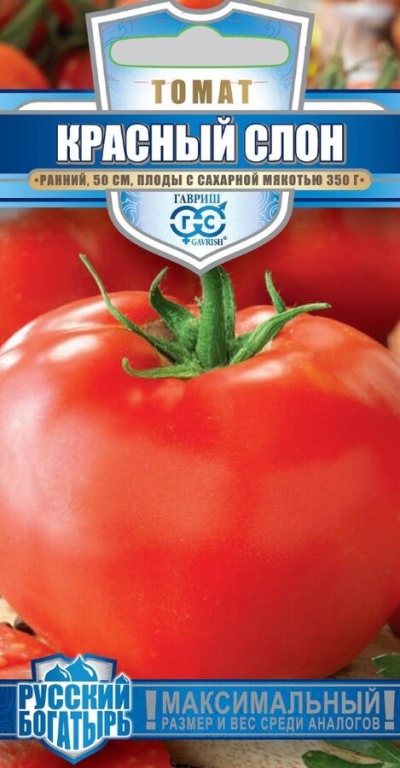
- Authors: Gavrish S.F., Degovtsova T.V., Artemyeva G.M., Redichkina T.A. (LLC "Gavrish Breeding Firm")
- Year of approval: 2018
- Category: grade
- Growth type: determinant
- Appointment: fresh consumption, for canning in slices, for juice, for ketchup and tomato paste
- Ripening period: early
- Ripening time, days: 100-105
- Growing conditions: for film greenhouses, for greenhouses
- Bush size: undersized
- Bush height, cm: 50
Everyone who has tasted a tomato at least once will never forget its taste. In addition, tomatoes grown on our own plot of land are much tastier, healthier than those bought in stores, as they ripen in the sun until they are ready.
Description of the variety
The red elephant is a determinate variety, so it reaches a certain height and no longer stretches upward. It is the ideal solution for all kinds of greenhouses.
The fruits are delicious fresh, but they are also suitable for canning, juices and ketchups.
The bushes are short, with a maximum height of 50 cm. The plants are vigorous, with strong foliage of medium size and green color.
The inflorescence of the Red Elephant is simple, there is an articulation.
The main qualities of the fruit
As with most varieties, the Red Elephant has a green tint when immature. The fruits are large, weighing from 300 to 350 grams. They are flat-round in shape, with medium ribbing. Up to 5 tomatoes can be formed on one brush.
The pulp is not too firm, very juicy. There are few seeds. One of the advantages of this tomato variety is long storage.
Taste characteristics
The fruits of the Red Elephant are prized for their unique sweetness.
Ripening and fruiting
The tomato of this variety belongs to the early, ripens in just 100-105 days from the moment of planting the seeds. Fruiting for a long time, the harvest begins in July and ends in August.
Yield
This is a productive variety, up to 13.6 kg are harvested per square meter. From a bush - about 9 kg.
The timing of planting seedlings and planting in the ground
In February-March, you can start planting seeds for seedlings. It is planted in the ground at the end of April or in May.

Growing tomato seedlings is an extremely important process, because it largely depends on whether the gardener can harvest at all. All aspects must be taken into account, from seedbed preparation to planting in the ground.
Landing scheme
The ideal planting pattern is 40x60 cm.

Growing and caring
The red elephant needs a garter and bush formation. Stakes are often used, while metal ones are better, since they do not develop fungus. Excess foliage from below is removed, like stepsons.
For growing tomatoes, slightly alkaline soil is suitable.If the soil is acidic, add some chalk and wood ash to increase the alkalinity of the soil. It is imperative to ensure the permeability of the soil at the stage of growing seedlings, so it is recommended to mix the soil mixture with sand in a ratio of 2: 1. During sowing and growing seedlings, the soil should be moist all the time, but not waterlogged.
The optimum temperature for growing Red Elephant tomatoes is around 20 ° C during the day and 17 ° C at night. The soil for growing tomatoes should be neither too heavy nor too light.
The tomato receives a significant amount of nutrients from the soil, so it must be fertilized correctly. It is worth choosing a fertilizer designed for this type of crop. It contains natural humic substances that nourish plants. In addition, the bush is enriched with minerals - nitrogen, phosphorus and potassium.
Potassium is especially important - its lack leads to a lack of intense color and cracking of the fruit. Biologically active fertilizers are used for the first time after the emergence of seedlings or during planting of seedlings, the second time - after 14-16 days, and then the third and fourth times - after 14-16 days.
The water requirement of tomatoes depends on the phase of development - during the first 2-3 weeks, low humidity contributes to the formation of the root system. However, when the fruits appear, the need for water increases. If there is not enough moisture, then the fruits may not appear at all or they will be small and tasteless. The gardener should remember that it is necessary to water the Red Elephant at the root, avoiding wetting the leaves.
Tomatoes require a lot of care. It is worth taking a closer look at the plants every day. If they start to hurt, the leaves with age spots should be removed immediately.




A plant needs different micronutrients at each stage of growth. All fertilizers can be divided into two groups: mineral and organic. Folk remedies are often used: iodine, yeast, bird droppings, eggshells.
It is important to observe the rate and period of feeding. This also applies to folk remedies and organic fertilizers.
Disease and pest resistance
The red elephant is highly resistant to late blight; other diseases must be regularly sprayed.
For diseases, fungicides or copper sulfate are used, for pests - insecticides.


Growing regions
Red elephant tomatoes can be grown almost throughout our country. This is not only the Moscow region, but also the Central District, the North Caucasus and even the Far East. Everywhere you can get a rich harvest, if you follow the rules of agricultural technology.

























































































